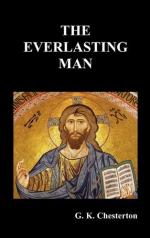|
This section contains 783 words (approx. 2 pages at 400 words per page) |

|
The Everlasting Man Summary & Study Guide Description
The Everlasting Man Summary & Study Guide includes comprehensive information and analysis to help you understand the book. This study guide contains the following sections:
This detailed literature summary also contains Topics for Discussion and a Free Quiz on The Everlasting Man by G. K. Chesterton.
The history of the world highlights two major facts, both of which contradict the anti-religious and even anti-human theories that have become fashionable in academic circles. The first of these facts is that man, though certainly an animal, is distinguished from all other animals by his possession of reason. On account of this rational nature, man naturally wants to know God, whose existence he can only vaguely grasp through the various mythologies and philosophies he creates. The second fact is that the Christian religion is unique in its ability to satisfy man's yearnings by revealing God to man in a way that would otherwise be impossible.
Though the theory of evolution in its entirety is not contested in this book, many of its proponents suppose that it proves that every aspect of man, including his rational nature, is subject to the same laws of gradual development. While man's body may indeed be the product of such a process, his reason is patently not. This is obvious from the fact that there is no parallel in nature. Animals resemble man in every other aspect; a dog or a bird might have a skeleton that in someway resembles the skeleton of a man, for example. However, there is nothing that resembles man's reason, even poorly. The difference between a monkey and a man is not merely that a man draws better than a monkey; the difference is that a man draws and a monkey does not draw at all. Archaeological evidence only confirms this. Cave drawings, however primitive the style and technique may be, reflect the same fundamental human nature that takes pleasure in reflecting upon what it sees and tackling the challenge of representing it. The drawings differ from Rembrandt only in skill, no matter how great that difference may be. Yet, certain scientists are so beholden to their theories that they tend to gloss over this fact. Instead of drawing conclusions from what evidence is available, they suppose that the cave-man must have been an unprecedented brute, basing their theories on no evidence at all.
The theory of evolution has become so fashionable that scholars of other fields have found ways to incorporate it into their own studies. Thus, for example, historians suppose that religion is an evolution from the crude starting point of tribal spiritualism to the more sophisticated theologies of modern religion. Such an explanation, of course, completely guts religion. It is no longer a spiritual revelation, but a product of merely natural and inevitable process. However, these historians miss the mark in the same way the anthropologists did: They put their theory before the facts. There is great evidence to suggest that monotheism is the primitive religion and the polytheistic mythologies of antiquity are a response to it. A single, transcendent God is, in a way, too transcendent for the Pagan mind to comprehend, and rightly so. It is only natural, then, that they try to make Divinity something more comprehensible by inventing gods not unlike themselves, who walk around, play jokes, and even sin. There is something deeply unsatisfying about this approach, for, however imaginative it might be, it does nothing to satisfy man's desire to understand. This desire is what motivated the great philosophers, like Aristotle or Plato, to create their great, abstract theories of metaphysics and ethics. It is difficult for a modern person to understand the relationship between philosophy and mythology. It would not be inaccurate to say that there was no relationship; the two, however contradictory they might have been, coexisted side-by-side.
This tenuous coexistence could not last forever, though, and gradually Paganism began to decline from the heights it reached in Rome. People began to become bored with their gods and began to turn to other, less benevolent gods or even no gods at all. Morality declined and sensuality reigned. The stage was set for the arrival of Christianity, a religion unique in its ability to satisfy the desires represented by mythology and philosophy. Like mythology, it was a story and, indeed, a tangible story, for God had become tangible. However, like philosophy, it was true, and its truth could be understood not only by the imagination but by reason. In other words, Christianity was the religion man had longed for along. Its existence, from the very beginning, was not to be an easy one, however. From Roman persecution to modern, scholarly persecution, the Catholic Church has constantly had to face adversity which should destroy any merely natural institution; indeed, at times, it seems as if the Catholic Church had been crushed. Each time, however, not only has the Catholic Church survived, but it has risen anew, stronger than ever.
Read more from the Study Guide
|
This section contains 783 words (approx. 2 pages at 400 words per page) |

|



